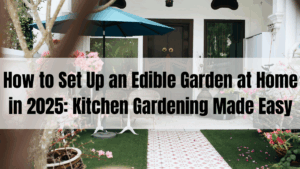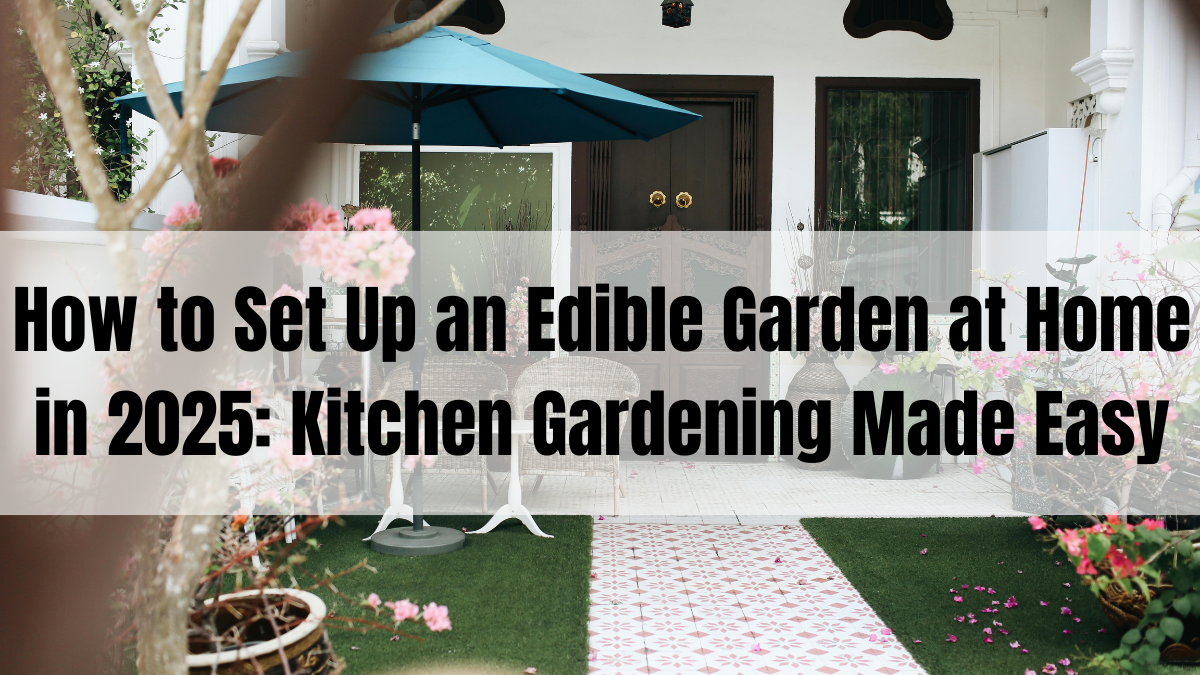In 2025, the Edible Garden Setup trend is growing faster than ever, as more Indian households turn balconies, rooftops, and even windowsills into mini farms. This transformation is not just about sustainability—it’s about better health, fresher ingredients, and cost-saving habits.
Whether you’re living in a spacious home or a compact apartment, the joy of growing your own herbs and vegetables is unmatched. With a few smart steps and basic tools, anyone can embrace Kitchen Garden Planning with ease and purpose.

Why Should You Start an Edible Garden Setup?
-
Beat rising food costs with home-grown produce
-
Avoid harmful pesticides found in market veggies
-
Bring therapeutic calmness and greenery into your living space
-
Reduce your carbon footprint with zero-mile food
-
Get kids involved in learning about nature and nutrition
Step-by-Step Kitchen Garden Planning for Beginners
1. Pick the Right Location
The foundation of every good Edible Garden Setup is light. Choose a space that gets 4–6 hours of daily sunlight.
-
Balcony: Use railings and hanging pots
-
Windowsills: Grow small herbs like mint and basil
-
Rooftops: Create raised beds or use grow bags
2. Choose Easy Edibles to Start With
When starting your Kitchen Garden Planning, begin with beginner-friendly and quick-growing plants.
| Type | Examples |
|---|---|
| Leafy Greens | Spinach, lettuce, fenugreek (methi) |
| Root Veggies | Carrot, radish, beetroot |
| Fruity Veggies | Tomato, cucumber, okra |
| Herbs | Mint, coriander, basil, curry leaves |
3. Use the Right Containers
Based on your available space, use:
-
Plastic or clay pots
-
Cement troughs
-
Hanging baskets
-
Recycled buckets or paint cans
Ensure containers have proper drainage holes to avoid waterlogging.
4. Soil Mix and Fertilizer
For a healthy Edible Garden Setup, mix:
-
50% garden soil
-
25% compost (cow dung or vermicompost)
-
25% coco peat
Add crushed neem leaves or neem cake powder to prevent fungal infections.
5. Follow a Seasonal Planting Plan
Organize your Kitchen Garden Planning around seasons to ensure year-round supply.
| Season | Best Crops |
|---|---|
| Winter (Oct–Feb) | Spinach, coriander, mustard |
| Summer (Mar–Jun) | Tomatoes, chili, okra |
| Rainy (Jul–Sep) | Beans, bitter gourd, cucumber |
6. Watering and Maintenance
-
Water your plants early morning or late evening.
-
Spray neem oil weekly to protect against pests.
-
Loosen topsoil regularly to maintain air flow to roots.
Creative Space-Saving Ideas for Urban Gardens
-
Vertical gardens with hanging bottles or racks
-
Wall-mounted planters using PVC pipes
-
Tiered shelves on balconies for layered planting
-
Herb jars on kitchen windows with glass jars
Budget Tools to Get You Started
-
Hand trowel and pruner
-
Water spray bottle
-
Grow bags (starting ₹30)
-
Compost bins
-
Organic seeds (buy local)
FAQs
What are the best vegetables for first-time edible gardeners?
Start with spinach, coriander, tomato, and mint – they are easy to grow and require low maintenance.
Can I set up an edible garden indoors?
Yes, with good sunlight or LED grow lights, you can grow herbs and leafy greens indoors easily.
How often should I water my kitchen garden?
Once daily in summer, and every alternate day in winter or monsoon. Always check soil moisture first.
Do I need fertilizers for my edible garden setup?
Yes, use organic compost every 2–3 weeks to boost plant health and yield.
How do I protect my plants from pests?
Spray a neem oil and water mix weekly. You can also plant marigolds nearby to deter insects.
Click here to know more.
